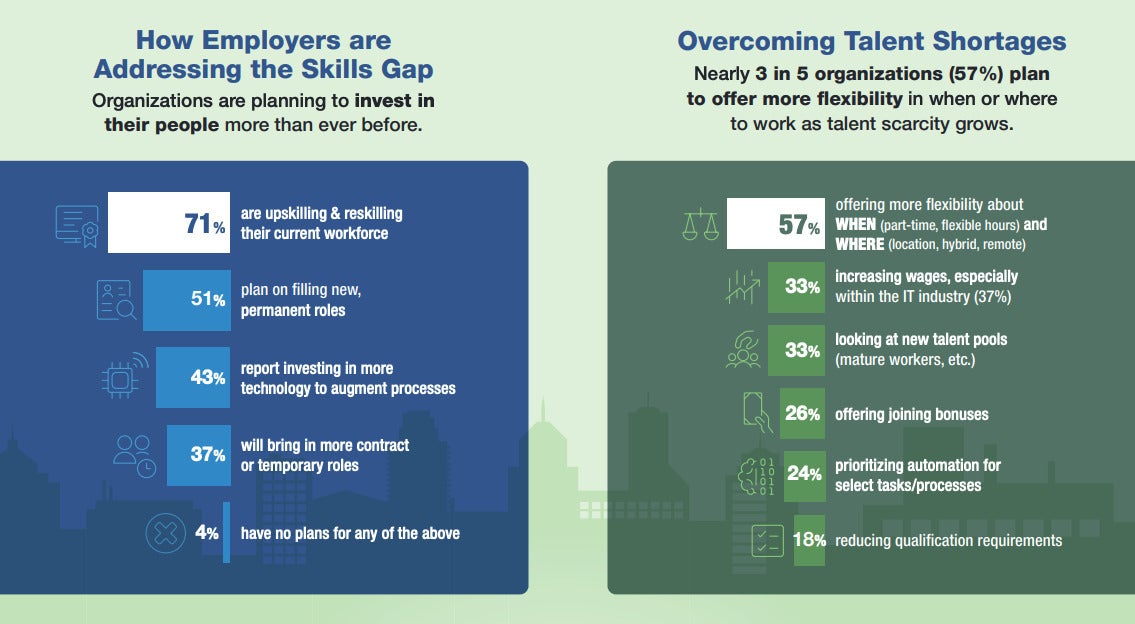































A new report shows that 77% of employers worldwide are finding it difficult to fill open job roles, which represents a 17-year-high talent shortage, according to multinational staffing firm ManpowerGroup.
The annual survey of 39,000 employers across 41 countries showed a 2% year-over-year increase in employers who said they're struggling to fill roles; that's more than double the difficulty reported in 2010 (31% of employers at that time).
 ManpowerGroup
ManpowerGroup Unmet demand for talent is highest in IT-related fields, with 78% of employers in IT reporting challenges in hiring. This suggests that tech workers who have found themselves laid off recently will soon be reabsorbed into the market, according to ManpowerGroup.
The plethora of job openings and dearth in available talent make an odd juxtaposition with numerous high-profile layoffs in the technology industry and elsewhere during the past six months or so. Industry experts have said many organizations over-hired during the COVID-19 pandemic and are now having to trim their workforces, a so-called "course correction."
This year, more than 168,000 workers have been laid off at tech firms, according to industry tracker Layoffs.fyi.
"While we are continuing to see layoffs against the backdrop of organizations struggling to fill IT roles, we are also seeing companies struggle to find talent with the skills they need to feel specific roles," said Amanda Alwy, senior vice president of North America Technology & Analytics at ManpowerGroup. "Our Manpower Employment Outlook Survey found that in the IT sector, 76% of employers say they are having a difficult time finding the right people with the right skills."
The survey also reports that many IT companies still plan to hire. The IT sector is considered among the most optimistic when it comes to hiring, Alwy added. Some 34% of organizations in the IT industry have high intentions to hire, followed by communication services (30%) and financial services and real estate (29%), according to the survey.
 ManpowerGroup
ManpowerGroup "The connection of tech industry layoffs vs. the shortage across all companies is that in many cases these tech companies are reducing not the highly skilled engineers, developers, etc. but more of the ancillary support roles," Alwy said.
Zachary Chertok, a research manager for IDC's Employee Experience group, said the current layoffs are "very much industry-specific and are being driven by calls for business efficiency in the face of tightening capital."
Industries that grew rapidly during COVID encountered redundant talent, bloated operating models, excess talent, or some combination of any or all three, he explained.
"As capital got more expensive with rising interest rates... the ability to finance bloated ongoing operational activities rose, forcing them to use cash on hand where available or seek more efficient operating measures," Chertok said. "Where some companies are engaging in layoffs more than others - even within sectors being noted for their layoffs - the layoffs are more about business realignment and efficiency than about 'follow-the-leader' or even about revenue."
Compared with other regions of the world, hiring expectations in North America are the highest; that aligns with a US unemployment rate that is currently the lowest since 1969. All industries and sectors indicate hiring more people in the first quarter.
The global labor market continues to defy signs of economic problems, such as inflation, with another robust hiring outlook for the quarter ahead, according to Becky Frankiewicz, president and chief commercial officer for ManpowerGroup, North America.
 ManpowerGroup
ManpowerGroup "Employers are still impacted by pandemic paranoia - they remember how long it took to bring workers back and are holding onto and hiring business-critical talent," Frankiewicz said in a statement. "We're still seeing concentration of demand in our real-time data, and this survey reflects concentration too, with IT leading the way in hiring plans despite layoffs dominating the headlines."
Unemployment in the US tech sector did jump from 1.5% in January to 2.2% in February, according to data released by the Bureau of Labor Statistics (BLS) and CompTIA, a nonprofit association for the IT industry and workforce. But the unemployment rate for tech occupations is still less than half that of the overall unemployment rate of 3.5%.
In January, online job site Indeed released its list of the 25 best jobs in the US, and nearly half were IT positions; the top slot went to full stack developer, which offers a median annual salary of$130,000 and allows for a mostly remote or hybrid workplace.
In fact, eight tech jobs were among the top 10 positions on this year's list, compared to just two tech jobs in the top 10 on last year's list. In 2022, tech jobs were moving down the top jobs list; now, a year later, tech jobs are surging upward. This year, 11 of the top 25 jobs, or 44%, were tech positions. By comparison, in 2022, just 25% of the top 25 jobs were tech-related.
Workers with in-demand tech and soft skills will find themselves in high demand, according to ManpowerGroup's Frankiewicz. The need to reskill today for tomorrow's jobs remains urgent as talent shortages grow, she added.
Janice Burns, chief people officer at education tech company Degreed, said the only path to filling critical open roles for many companies is reskilling existing employees. More organizations, Burns said, will likely supplement their learning and development (L&D) teams with data analysts, data scientists, and business intelligence personnel to train others.
"This might be a dedicated person, or depending on resources, they might upskill existing L&D team members. It's an exciting opportunity for L&D, because having access to data and the people to analyze it will give them more of a voice in strategic conversations," Burns said in an email to Computerworld. "This might finally be the year where L&D doesn't just get a seat at the boardroom table but drives it, with tangible skill data and business value results."
 ManpowerGroup
ManpowerGroup IDC's Chertok said upskilling and reskilling have potential to answer to some of the issues related to the dearth of talent. Additionally, organizations should have a broader focus on internal mobility and working to a skills-based ideology, even if the company continues to engage in role-based hiring.
Employee experience and engagement tools, such as Microsoft Viva or Lattice Engagement, let employees' voices be heard, allowing them to express their ideas, grievances, and suggestions. Combining people analytics with performance management tools can help identify the right existing talent for open roles as the organization changes and transitions across new operating models and new economic models, according to Chertok.
"Identifying skills is only one piece of the equation to enhance organizational nimbleness, with another key piece being understanding the nature of the individual employee and how they fit into different teams, divisions, etc." Chertok said. "Pairing the skills with the person is vital to ensuring equitable placement for performance and productivity.
"In the meantime," he continued, "oganizations need to better embrace workforce planning for organization-level shifts above and beyond skills and experience factors at the individual level."
 Горячие метки:
Работа в сфере информационных технологий
Работа по найму
Навыки работы с ит
Обучение в области информационных технологий
Стратегия в области ит
Горячие метки:
Работа в сфере информационных технологий
Работа по найму
Навыки работы с ит
Обучение в области информационных технологий
Стратегия в области ит